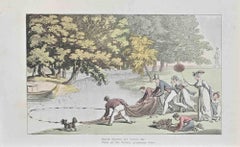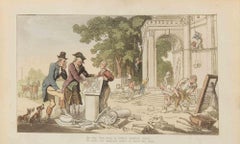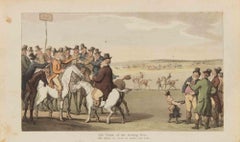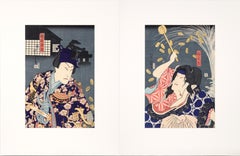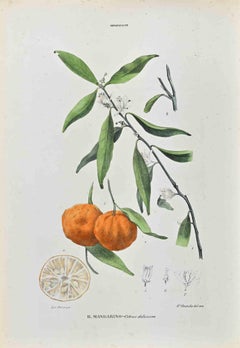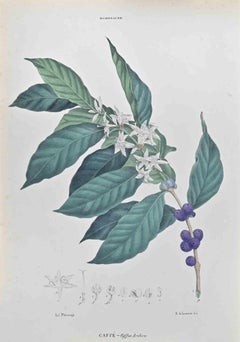19th Century Figurative Prints
to
346
6,303
1,006
182
50
40
Overall Width
to
Overall Height
to
5,405
354
123
55
34
25
16
7
2
269
123
115
112
102
3,530
7,597
25,433
6,812
292
597
1,408
1,236
1,327
2,299
3,258
5,194
2,840
1,347
3,028
4,463
3,075
41
5,243
2,673
2,075
1,786
1,525
1,056
862
574
547
510
507
502
433
291
243
239
228
220
208
197
4,334
2,106
682
675
445
325
5,652
4,093
764
Period: 19th Century
Rural Sports are Better - Etching by Thomas Rowlandson - 1817
Located in Roma, IT
Etching and aquatint realized by Thomas Rowlandson in 1817. Plate from "The Dance of Life" by William Combe.
Very good condition.
Thomas Rowlandson (1757-1827) was an english artis...
Category
Modern 19th Century Figurative Prints
Materials
Etching
As the First Step in Folly's Wanton Waste - Etching by Thomas Rowlandson - 1817
Located in Roma, IT
Etching and aquatint realized by Thomas Rowlandson in 1817. Plate from "The Dance of Life" by William Combe.
Very good condition.
Thomas Rowlandson (1757-1827) was an english artis...
Category
Modern 19th Century Figurative Prints
Materials
Etching
The Victim of the Betting Post - Etching by Thomas Rowlandson - 1817
Located in Roma, IT
Etching and aquatint realized by Thomas Rowlandson in 1817. Plate from "The Dance of Life" by William Combe.
Very good condition.
Thomas Rowlandson (1757-1827) was an english artis...
Category
Modern 19th Century Figurative Prints
Materials
Etching
The Samurai Genta Kajiwara - Japanese Woodblock Diptych in Ink on Paper
Located in Soquel, CA
The Samurai Genta Kajiwara - Japanese Woodblock Diptych in Ink on Paper
Boldly colored woodblock by Utagawa Yoshitora (Japanese, active c.1840-1880)...
Category
Edo 19th Century Figurative Prints
Materials
Paper, Ink, Woodcut
$1,280 Sale Price
20% Off
The Auranziaceae - Lithograph by Vincenzo Tenore - 1870s
Located in Roma, IT
Lithograph hand watercolored.
Plate from "Atlante di Botanica popolare ossia Illustrazione di Piante Notevoli di ogni famiglia" (Atlas of popular botany or illustration of notable p...
Category
Modern 19th Century Figurative Prints
Materials
Lithograph
Coffee - Lithograph by Vincenzo Tenore - 1870s
Located in Roma, IT
Lithograph hand watercolored.
Belongs to the Series "Atlante di Botanica popolare ossia Illustrazione di Piante Notevoli di ogni famiglia" (Atlas of popular botany or illustration o...
Category
Modern 19th Century Figurative Prints
Materials
Lithograph
The Dance of Life Begins - Etching by Thomas Rowlandson - 1817
Located in Roma, IT
Etching and aquatint realized by Thomas Rowlandson in 1817. Plate from "The Dance of Life" by William Combe.
Very good condition.
Thomas Rowlandson (1757-1827) was an english artis...
Category
Modern 19th Century Figurative Prints
Materials
Etching
Vue de Mantes - Etching after C. Corot by C. Pinet - 19th Century
Located in Roma, IT
Vue de Mantes is a beautiful artwork realized by Charles Pinet after a painting by Camille Corot in the middle of XIX century.
This etching represents a natural landscape with some...
Category
Old Masters 19th Century Figurative Prints
Materials
Etching
Bathing at Long Branch-“Oh, Ain’t it Cold”
Located in Fairlawn, OH
Bathing at Long Branch-“Oh, Ain’t it Cold”
Wood engraving, 1871
Signed in the block with the artist's initials "WH", see photo
Published in: Every Saturday, Aug. 16, 1871
Condition: ...
Category
Hudson River School 19th Century Figurative Prints
Materials
Woodcut
Morning Awakening
Located in PARIS, FR
"Morning Awakening"
from the series "The Times of the Day"
Original lithograph
Signed "Mucha" and dated "99" for 1899, at the lower part of the plate.
There is no hand-written signa...
Category
Art Nouveau 19th Century Figurative Prints
Materials
Paper
Set 5 Antique French Engravings Ancient Roman Artefacts & Figures
Located in Cirencester, Gloucestershire
Set of 5 black and white engravings
French School, 19th century
each paper (unframed) : 9 x 12 inches
provenance: private collection
condition: good and sound condition, old foxing s...
Category
Rococo 19th Century Figurative Prints
Materials
Engraving
La Fantasie
Located in Middletown, NY
Engraving on cream laid paper, 7 x 3 1/2 inches (177 x 90 mm), full margins. An engraving by the artist after his own drawing which is housed in the permanent collection of the Metro...
Category
French School 19th Century Figurative Prints
Materials
Laid Paper, Engraving
Edward Strauss, Vanity Fair composer violinist music portrait, 1895
Located in Melbourne, Victoria
'Eduard Strauss'
Chromolithograph, 1895.
Vanity Fair musician portrait of Eduard Strauss (1835 – 1916) the Austrian composer.
400mm by 270mm (sheet)
Category
Victorian 19th Century Figurative Prints
Materials
Lithograph
Bijinga - Woodcut by Utagawa Toyohiro - Early 19th Century
Located in Roma, IT
Bijinga (New year festivities) is an original modern artwork realized by Utagawa Toyohiro in the Early 19th Century.
Woodcut Print Oban Format
New year festivities, two elegant la...
Category
Modern 19th Century Figurative Prints
Materials
Paper, Woodcut
The Doctor Bird Ready For Injection - Lithograph by J.J Grandville - 1852
Located in Roma, IT
The Doctor Bird Ready For Injection is an original lithograph on ivory-colored paper realized by J.J. Grandville from Scènes de la vie privée et publique des animaux, 1852. Published...
Category
Modern 19th Century Figurative Prints
Materials
Paper, Lithograph
Kabukie - The Province of Rokuok - Woodcut by Utagawa Kunikazu - 1862
By Utagawa Kunikazu
Located in Roma, IT
Kabukie - The Province of Rokuoku is an original artwork realized in 1862 by Utagawa Kunikazu (1830 - 1919)
Chuban.
From the series "Dai Nippon rokuju of Rikuoku" (60 provinces of Glorious Japan), The Province of Rokuoku.
Meeting of the two rivals in the forest at night, Tanigoro with sumo apron and fan with the national colours.
Signed: Kunikazu.
Good impression, backed, glued at corners, oxidation, centrefold, a little bit rubbed.
Utagawa Kunikazu (1830 - 1919) was a printmaker from Osaka. He had a famous teacher, the ukiyo-e artist Kunisada Utagawa...
Category
Modern 19th Century Figurative Prints
Materials
Woodcut
Woman at the Tub (Femme au tub)
Located in Bournemouth, Dorset
Henri de Toulouse-Lautrec (1864–1901)
Woman at the Tub (Femme au tub)
lithograph, 213/275, signed in print
Image: 48.5 x 62.5 cm
Frame: 69.5 x 81.5 cm
Henri Toulouse-Lautrec (1...
Category
Realist 19th Century Figurative Prints
Materials
Lithograph
$1,107 Sale Price
20% Off
Marphise (Tire de l'Arioste), Old Masters Lithograph after Eugene Delacroix
Located in Long Island City, NY
Eugene Delacroix, After by Eugene LeRoux, French (1798 - 1863) - Marphise (Tire de l'Arioste), Year: circa 1850, Medium: Lithograph, Image Size: 10.5 x 13 inches, Size: 19.25 x 2...
Category
Old Masters 19th Century Figurative Prints
Materials
Lithograph
Uses and Customs - Villa Carlotta, già Clerici e Sommariva...- Lithograph - 1862
Located in Roma, IT
Uses and Customs - Villa Carlotta, già Clerici e Sommariva on Lake Como is a lithograph on paper realized in 1862.
The artwork belongs to the Suite Uses and customs of all the peopl...
Category
Modern 19th Century Figurative Prints
Materials
Lithograph
Portrait of Turkish Sultan Cadi-Lechker - Original Lithograph - Mid 19th Century
Located in Roma, IT
Portrait of Turkish Sultan Cadi-Lechker is an original Lithograph realized by an anonymous artist in the mid 19th Century.
Good conditions.
The artwo...
Category
Modern 19th Century Figurative Prints
Materials
Lithograph
Five images from the popular 1886 Spanish Bullfighting Journal La Lidia
Located in Paonia, CO
La Lidia, the oldest and most popular bullfighting magazine was founded by Julian Palacios the owner of a prestigious lithograph and engraving workshop in Madrid. These colorful...
Category
Realist 19th Century Figurative Prints
Materials
Lithograph
Customs - Persian Deities - Lithograph - 1862
Located in Roma, IT
Customs - Persian Deities is a lithograph on paper realized in 1862.
Titled on the lower.
The artwork belongs to the Suite Uses and customs of all the peoples of the universe: " Hi...
Category
Modern 19th Century Figurative Prints
Materials
Lithograph
Rônin in the Night, Armed with a Club - Woodcut by Utagawa Kunisada-19th Century
Located in Roma, IT
This magnificent woodcut print signed Toyokuni III represents a Ronin in the night, armed with a club, and was realized by Utagawa Kunisada (1786-1865) in the mid 19th Century.
The ...
Category
Old Masters 19th Century Figurative Prints
Materials
Woodcut
Judge Dai Hanji Kiyozumi - Woodcut Print by Utagawa Kunisada - 1859
Located in Roma, IT
Judge Dai Hanji Kiyozumi is an original modern artwork realized by Utagawa Kunisada in 1859.
Woodcut Print Oban Format, from a triptych, 1859.
Actor in the role of Judge Dai Hanji ...
Category
Modern 19th Century Figurative Prints
Materials
Woodcut
Kabuki Actor in Water Lily Robe with Samurai Sword - Japanese Woodblock Print
Located in Soquel, CA
Kabuki Actor in Water Lily Robe with Samurai Sword- Japanese Woodblock Print
Finely detailed woodblock by Utagawa Toyokuni (Japanese, 1769-1825). A kabuki actor ("Master Haranyuki Sawamura") is standing on stage with mountainous backdrop, wearing a robe in a water lily pattern. He is wearing a samurai sword.
Presented in a gold colored frame with a silk mat.
Frame size: 20"H x 14.25"W
Image size: 14"H x 9"W
Utagawa Toyokuni (Japanese, 1769-1825) was born in Edo, the son of Kurahashi Gorobei, a carver of dolls and puppets...
Category
Edo 19th Century Figurative Prints
Materials
Ink, Rice Paper, Woodcut
Les Gens de Justice - Lithograph by Honoré Daumier - 1845
Located in Roma, IT
Lithograph realized by Daumier in 1845, belonging to the Series "Les Gens de Justice"
Table no. 20 of the Series.
Monogrammed in the plate.
Very good condition.
Ref. Delteil 1356
Category
Modern 19th Century Figurative Prints
Materials
Lithograph
Mending the Tears
Located in New York, NY
Winslow Homer created this etching entitled “MENDING THE TEARS” in 1888. This is a lifetime impression signed by Homer and printed by the famous New York etcher George W. H. Ritchie.
This piece is signed in pencil “Winslow Homer, N.A.” in the lower left above the etched remarque of an anchor. Etched above the image (top left) is “Copyright, 1888 by Winslow Homer N.Y.” and (top right) “G. W. H. Ritchie Imp.” Also etched in the plate (lower right) “Winslow Homer Sc.” ). The printed image size 15.25 x 21.5" (38.8 x 54.5 cm) plus margins – printed on Japan paper. This item is in very good condition and framed in 2.25 inch scooped molding finished in gold leaf with a rag stock bevel (mat edge) wrapped in metal leaf and rag stock top mat wrapped in silk. Glazed in TruVue Museum Glass.
“Winslow Homer (1836-1910) was one of America's great artists of the 19th century and the sea...
Category
American Impressionist 19th Century Figurative Prints
Materials
Etching
Le Supplice du Garrot, Old Masters Heliogravure Etching by Francisco de Goya
Located in Long Island City, NY
Francisco de Goya, After by Amand Durand, Spanish (1746 - 1828) - Le Supplice du Garrot, Year: 1875, Medium: Heliogravure, Size: 12.5 x 8.5 in. (31.75 x 21.59 cm), Printer: Amand Durand, Description: An Amand Durand etching...
Category
Old Masters 19th Century Figurative Prints
Materials
Etching
Strychnos Tieuté - Lithograph by Vincenzo Tenore - 1870s
Located in Roma, IT
Lithograph hand watercolored.
Belongs to the Series "Atlante di Botanica popolare ossia Illustrazione di Piante Notevoli di ogni famiglia" (Atlas of popular botany or illustration o...
Category
Modern 19th Century Figurative Prints
Materials
Lithograph
"Dawn Inside the Yoshiwara" Utagawa Hiroshige, Japanese Landscape, Ukiyo-e
Located in New York, NY
Utagawa Hiroshige
Dawn Inside the Yoshiwara, circa 1857
Woodblock print
11 x 7 inches
Utagawa Hiroshige is recognized as a master of the ukiyo-e woodblock printing tradition, havin...
Category
Naturalistic 19th Century Figurative Prints
Materials
Paper, Ink, Woodcut
Indian Giant Squirrel - Original Lithograph by Paul Gervais - 1854
By Paul Gervais
Located in Roma, IT
Indian Giant Squirrel is an original lithograph on ivory-colored paper, realized by Paul Gervais (1816-1879). The artwork is from The Series of "Les Trois Règnes de la Nature", and w...
Category
Modern 19th Century Figurative Prints
Materials
Lithograph
Genji in the Twelve Months - Woodcut by Utagawa Toyokuni III - 1858
Located in Roma, IT
Genji in the Twelve Months / The Tenth Month (Moto) is a tryptich woodcut print realized by Utagawa Toyokuni III in 1858.
Very good condition except for some minor signs of wear.
Category
Modern 19th Century Figurative Prints
Materials
Woodcut
Tp Part with Thee, my Boy - Etching by Thomas Rowlandson - 1817
Located in Roma, IT
Etching and aquatint realized by Thomas Rowlandson in 1817. Plate from "The Dance of Life" by William Combe.
Very good condition.
Thomas Rowlandson (1757-1827) was an english artis...
Category
Modern 19th Century Figurative Prints
Materials
Etching
For my Own Good and Yours' I'm Bent- Etching by Thomas Rowlandson - 1817
Located in Roma, IT
Etching and aquatint realized by Thomas Rowlandson in 1817. Plate from "The Dance of Life" by William Combe.
Very good condition.
Thomas Rowlandson (1757-1827) was an english artis...
Category
Modern 19th Century Figurative Prints
Materials
Etching
Tis hop'd, Miss Foreign Scenes - Etching by Thomas Rowlandson - 1817
Located in Roma, IT
Etching and aquatint realized by Thomas Rowlandson in 1817. Plate from "The Dance of Life" by William Combe.
Very good condition.
Thomas Rowlandson (1757-1827) was an english artis...
Category
Modern 19th Century Figurative Prints
Materials
Etching
William Hamilton Classical Greek Vase-Painting Engraving
Located in Melbourne, Victoria
Subject : Ancient Greek vase-painting depicting a toilet scene with three women from an Attic hydria, now in the British Museum.
Technique : Copper-line engraving with original han...
Category
Other Art Style 19th Century Figurative Prints
Materials
Engraving
Opus IV, Simplicius in der Waldeinode - Etching by Max Klinger - 1881
By Max Klinger
Located in Roma, IT
Opus IV, Simplicius in der Waldeinode (Simplicius in the Wilderness) belongs to a series of prints called Intermezzi realized by Max Klinger, published by Nurnberg: Stroefer, 1881.
...
Category
Symbolist 19th Century Figurative Prints
Materials
Etching
View of Avellino - Etching by Tommaso Piroli - Mid-19th century
Located in Roma, IT
View of Avellino is a print realized by Tommaso Piroli in the mid-19th century.
Etching Hand-watercolored on paper.
Signed and titled on the plate.
Good conditions with foxing
Category
Contemporary 19th Century Figurative Prints
Materials
Etching
Le Roi Peste (The Plague Kings) - Etching by James Ensor - 1895
By James Ensor
Located in Roma, IT
The Plague Kings is an original etching on the Japanese paper, realized by James Ensor in 1895, signed on the plate and dated, unique state, with the second signature on the reverse ...
Category
Surrealist 19th Century Figurative Prints
Materials
Etching
Bear and Elf from "Intermezzi" - Etching by Max Klinger - 1881
By Max Klinger
Located in Roma, IT
Bear And Elf from "Intermezzi" is a print realized by Max Klinger in 1881.
Signature and number of the print on plate.
Black and white etching and aquatint. Original title: Bär und...
Category
Symbolist 19th Century Figurative Prints
Materials
Etching
Antoine Louis-Barye "Walking Tiger" Antique Engraving by Firmin Gillot ca. 1870
Located in SANTA FE, NM
"Walking Tiger"
Antoine Louis-Barye
Antique Engraving by Firmin Gillot
Circa. 1870
11 1/3 x 7 3/4 (21 3/8 x 17 1/2 frame) inches
This is "Walking Tig...
Category
Realist 19th Century Figurative Prints
Materials
Black and White
The Thistle - Lithograph by Vincenzo Tenore - 1870s
Located in Roma, IT
Lithograph hand watercolored.
Belongs to the Series "Atlante di Botanica popolare ossia Illustrazione di Piante Notevoli di ogni famiglia" (Atlas of popular botany or illustration o...
Category
Modern 19th Century Figurative Prints
Materials
Lithograph
Ancient Etruscan Greek vase painting. Early 19th century engraving, 1808
Located in Melbourne, Victoria
Etruscan Vase-painting
Copper-line engraving with later hand-colouring. 1808. From Millin's 'Peintures de Vases Antiques' published in Paris in 1808.
Depicts scene from an ancient ...
Category
Other Art Style 19th Century Figurative Prints
Materials
Engraving
View of Quirinale Garden, Rome - Etching on Paper - 19th century
Located in Roma, IT
View of Quirinale Garden is an original etching on paper realized by an Anonymous artist of the XIX century, singed and titled on the plate with inscription below, Plate no. 72
Dime...
Category
Modern 19th Century Figurative Prints
Materials
Etching
Gerlach's Allegorien Plate #20: "Song, Love, Music, Dance" Lithograph
Located in Chicago, IL
Koloman Moser
(1868 –1918), AUSTRIAN
Instead of applying his flair and art education solely to painting, Koloman Moser embodied the idea of Gesamt Kunstwerk (all-embracing art w...
Category
Vienna Secession 19th Century Figurative Prints
Materials
Lithograph
Nature Morte
Located in Belgrade, MT
This colorful lithograph is part of my private collection since the 1970's. It is signed in the plate and also pencil signed on the print on the lower left corner.
Publisher: La Guil...
Category
Abstract Impressionist 19th Century Figurative Prints
Materials
Ceramic, Tapestry, Oil, Lithograph
$720 Sale Price
20% Off
Sanjûroku Kasen... - Woodcut by Mizuno Toshikata - 1893
Located in Roma, IT
Nishiki-e (woodcut print), in vertical oban format (31x20.5) realized by Mizuno Toshikata in 1893 (Meiji 26).
Belongs to the Series "Sanjûroku Kasen" (Thirty-Six Beauties in Compari...
Category
Modern 19th Century Figurative Prints
Materials
Woodcut
Yakushae - Woodcut Print by Utagawa Kunisada - 1863
Located in Roma, IT
Yakushae is an original modern artwork realized by Utagawa Kunisada in 1863.
Woodcut print oban from a tryptich. Signed Toyokuni ga. Publisher: Izutsuya. Scene from the play "Yowa Nasake Ukina no Yokogushi". Yasugoro, the thief with the bat tattoo on his cheek, enters the oil merchant's house at night...
Category
Modern 19th Century Figurative Prints
Materials
Woodcut
Self- Portrait - Etching by J.-P. Norblin de La Gourdaine
Located in Roma, IT
Self- Portrait is an etching on creamy-colored paper realized by Jean-Pierre Norblin de La Gourdaine artist in the Early 19th Century.
Good Conditions.
The artwork is depicted thr...
Category
Modern 19th Century Figurative Prints
Materials
Etching
$286 Sale Price
20% Off
Takanawa no Kihan - Woodblock print by Utagawa Hiroshige - 1843-1847
Located in Roma, IT
Takanawa no kihan is a modern artwork realized between 1843 and 1847 after Utagawa Hiroshige.
Ukiyo-e color woodblock print from the Touto hakkei (The Eight Famous Views of the Capital of the East) series.
Mounted under passepartout.
The artwork depicts the port of Takanawa, a suburb of Minato in southern Tokyo, and is one of the very rare sheets by Utagawa Ando Hiroshige...
Category
Modern 19th Century Figurative Prints
Materials
Woodcut
The Malta Mushroom - Lithograph by Vincenzo Tenore - 1870s
Located in Roma, IT
Lithograph hand watercolored.
Belongs to the Series "Atlante di Botanica popolare ossia Illustrazione di Piante Notevoli di ogni famiglia" (Atlas of popular botany or illustration o...
Category
Modern 19th Century Figurative Prints
Materials
Lithograph
La Danse (The Dance) - Original lithograph - 1897
Located in Paris, IDF
Armand Rassenfosse
La Danse, 1897
Original lithograph
Printed signature in the plate
On paper 40 x 31 cm (c. 16 x 12")
INFORMATION : Published by 'Estampe Moderne, Paris, 1897-1899...
Category
Art Nouveau 19th Century Figurative Prints
Materials
Lithograph
Gathering Scene - Woodcut by Utagawa Kuniyoshi - 1860 ca
Located in Roma, IT
Rare tryptich. Woodcut print nishike-e in loose sheets.
Utagawa Yoshikazu was a pupil of Utagawa Kuniyoshi and was active until around 1870. He is remembered for images of battles,...
Category
Modern 19th Century Figurative Prints
Materials
Woodcut
Iridescent Hibiscus - Lithograph by Vincenzo Tenore - 1870s
Located in Roma, IT
Lithograph hand watercolored.
Belongs to the Series "Atlante di Botanica popolare ossia Illustrazione di Piante Notevoli di ogni famiglia" (Atlas of popular botany or illustration o...
Category
Modern 19th Century Figurative Prints
Materials
Lithograph
Charles John Darling, lawyer, Vanity Fair caricature portrait, 1897
Located in Melbourne, Victoria
'Little Darling'
Chromolithograph. 1897.
Vanity Fair musician portrait of Charles John Darling (1849-1936), lawyer, politician and High Court judge.
395mm by 265mm (sheet)
Category
Victorian 19th Century Figurative Prints
Materials
Lithograph
City Justice, Vanity Fair legal chromolithograph of a judge, 1880
Located in Melbourne, Victoria
Vanity Fair legal portrait of Alderman Sir Robert Walter Carden KNT. MP.
380mm by 260mm (sheet)
Category
Victorian 19th Century Figurative Prints
Materials
Lithograph
Ira D Sankey, Vanity Fair singer and composer portrait chromolithograph, 1884
Located in Melbourne, Victoria
'Praise and Prayer'
Chromolithograph, 1874, after Ape (Carlo Pellegrini 1839-1889)
Vanity Fair portrait of Ira D. Sankey (1840 -1908), known as The Sweet Singer of Methodism, who w...
Category
Victorian 19th Century Figurative Prints
Materials
Lithograph
Sir August Friedrich Manns, composer, Vanity Fair caricature portrait, 1895
Located in Melbourne, Victoria
'Crystal Palace'
Chromolithograph. 1895.
Vanity Fair portrait of Sir August Friedrich Manns (1825-1907) who was a German-born conductor who made his career in England. After servi...
Category
Victorian 19th Century Figurative Prints
Materials
Lithograph
Bjrenomogeti Mushrooms - Lithograph by Vincenzo Tenore - 1870s
Located in Roma, IT
Lithograph hand watercolored.
Belongs to the Series "Atlante di Botanica popolare ossia Illustrazione di Piante Notevoli di ogni famiglia" (Atlas of popular botany or illustration o...
Category
Modern 19th Century Figurative Prints
Materials
Lithograph
PIERRE-AUGUSTE RENOIR "Enfants jouant à la balle"
Located in Los Angeles, CA
PIERRE-AUGUSTE RENOIR (1841-1919)
"Enfants jouant à la balle"
Lithograph in colors, on Arches Ingres laid paper watermark MBM, 1900, from the edition of 200, published by Ambroise V...
Category
19th Century Figurative Prints
Materials
Lithograph
Recently Viewed
View AllMore Ways To Browse
Kim Tschang Yeul
Tom Blackwell On Sale
Tom Everhart Lithograph
Torii Kotondo
Victor Richardson
Vintage Boulangerie Signs
Vintage Les Nereides
Vintage Meat Scales
Vintage Multiplier Reel
Warhol Northwest Mask
Whistler Fumette
Yoko Ono Lithograph Harold Town
Zeno Giglietti
Ak47 Lotus
Alex Katz Bicycle
Alex Katz Christy
Alex Katz Twilight
Alex Katz Wedding Dress
